Tonging for Oysters in Apalachicola
May 11, 2012
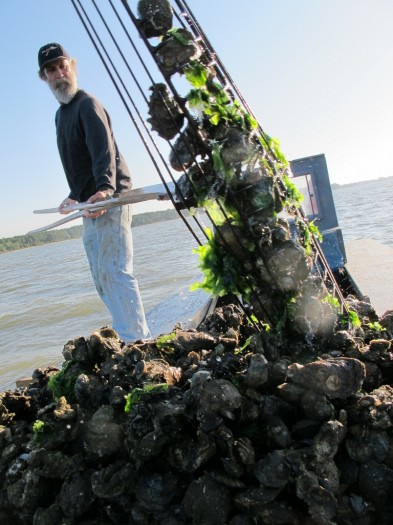
Apalachicola Bay is a time capsule. Unlike the rest of the country, which either harvests oysters using motorized dredges pulled behind boats, or farms oysters in bags and cages, Apalachicola Bay is full of oystermen working the bars the same way they have for centuries, using long, wooden-handled tongs to pull the oysters into tiny oysterboats, then culling the oysters by hand, filling sacks, and dropping them off at local restaurants and processors. They can still do that because the bay is just a few feet deep, lending itself more to tongs than to dredges, and, more important, because the bay is in such extraordinarily good health. Unlike pretty much the rest of the country, they haven’t killed their wild oysters yet. They still get an abundant spat set in the bay, enough to keep about 300 oystermen in work.
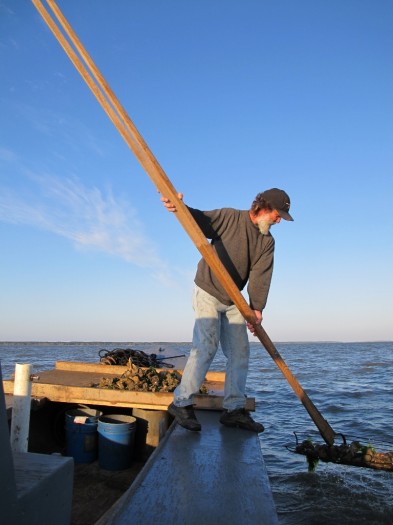
To get a sense of that work, I headed off at dawn one morning with Kendall Schoelles, a third-generation oysterman. I expected a blocky southerner with Incredible Hulk shoulders, but Kendall is normal sized. Yet somehow he manages to tong oysters for 8 or 9 hours a day.
Oysterboats are simple but functional, with wide sideboards for walking up and down with the tongs. Kendall reaches down with the tongs and feels around, fluffing the bottom a few times to find some solid (i.e., filled) shell and to gather it into the tongs. Then he pulls up 10 or 20 oysters, along with lots of old shell and the odd crab, and dumps everything on the culling board on the bow.
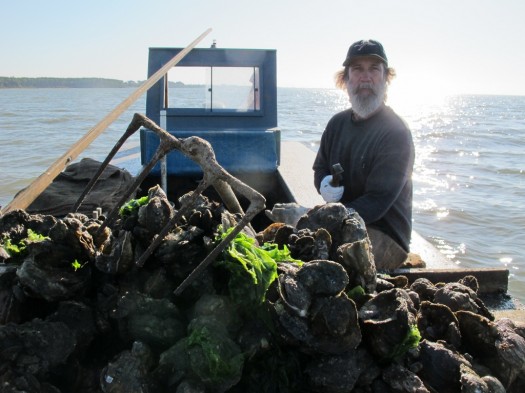
After an hour or two, the pile of oysters is high enough that each new tonging added to the top threatens to tumble overboard, at which point it’s time to cull them. Kendall grabs a culling iron and sets to work.
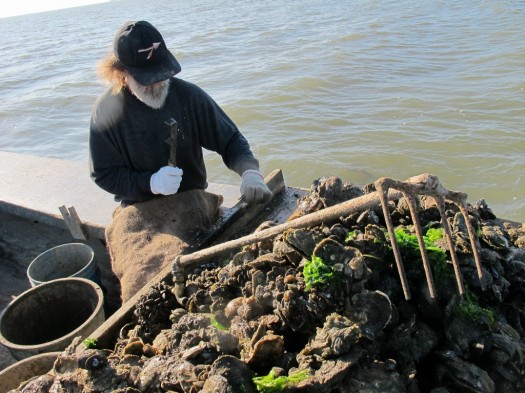
The culling iron has two metal flanges three inches apart–that’s the legal length for harvesting oysters. Anything smaller gets tossed back to the bottom to grow a little longer. In Apalachicola, it takes oysters 12-18 months to reach three inches, which is wicked fast. Thank those brown, plankton-rich waters for that (which means, thank the Apalachicola River for washing that nice Georgia mud down here).
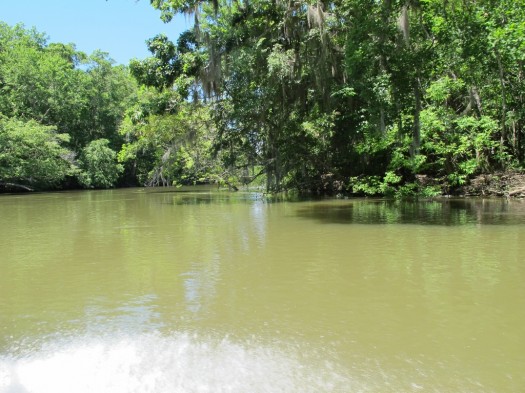
As larvae, oysters swim around looking for existing shell to attach to. They can actually smell it. They use a gluey substance to attach themselves to the shell, and then they are stuck for life. That’s why oyster reefs are so cohesive, and it’s why most of Kendall’s work day is spent bashing oyster clumps apart with his culling iron. I helped out, and that’s why, two weeks later, my thumb is still a disturbing shade of purple. Those culling irons carry some force.
The good oysters go into sacks. The going rate is $20/sack, up from $12/sack a couple of years ago. That’s for 300 large oysters! Think of that the next time you’re in Grand Central dropping $3 on a single shrimpy bivalve.
A lot of mussels, oyster drills (snails), and other oyster competitors/predators come up with the oysters. These Kendall smashes, and the soupy glob gets tossed overboard, so pretty quick there are swarms of huge catfish around the boat. It’s blissful to be out there, no other boats around, culling oysters, whacking your thumb, smelling the wind and water, listening to the catfish sloshing around the surface, and popping open the occasional oyster and eating it on the spot. (Best I’ve ever had.) At least, it was blissful in April. Kendall says that summer, “95 degrees, no wind,” is brutal, and winter is even worse. He admits that after a life of tonging in all sorts of weather, he hits the painkillers pretty hard in the evenings. Still, he couldn’t bear to be anywhere else, and he has no plans to stop anytime soon.
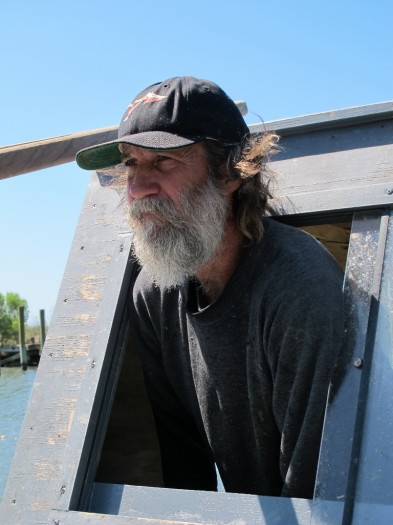
Personally, I think Apalachicola Bay should be a UNESCO World Heritage Site. Other than Kendall and a few others who have perspective, most of the oystermen in the area don’t appreciate the beauty and rarity of what they’ve got. Most of the rest of the country doesn’t have a clue. For the traditional way of life to go on in Apalachicola, we all need to seek out those oysters and be willing to pay more for them than we do now. $20 a sack is just nuts for a food that kicks the ass of the finest caviar, and is actually harder to find. But what we really need to do is support the groups that keep the bay healthy. That health is in no way assured, because it depends on the flow of water from the Apalachicola River. That water keeps the bay brackish, which keeps oyster predators out at sea. Anytime the river drops and the bay water turns saltier, the predator surge in and eat a ton of baby oysters. And lately, the river is always low, because it flows down from Georgia, and Atlanta has a little water problem. As the state o Georgia steals more and more of the Apalachicola River’s water to keep Atlanta’s pools full, less and less finds its way to the bay. If this keeps up, at some point oystering in Apalachicola will become unsustainable. That would be a crime. To learn more, you can visit the website of the Apalachicola Riverkeeper.
Better yet, visit Apalachicola itself and learn firsthand what it’s like to tong oysters. Here are a couple of guys who will take you out:
Doug Joyner; 850-524-5985; [email protected]
Oystering trips on the bay. We will teach you how to tong and cull your own oysters from Capt Doug’s oyster boat. You bring the hot sauce and the crackers and we’ll open the oysters for you!
Captain Don Davis; 850-566-4177; [email protected]
Captain Don Davis of Carrabelle has been a US Coast Guard licensed captain for over thirty years. Catch your own oysters in beautiful Apalachicola Bay. If weather permits, six hour trips will be taken.
« PREVIOUS: Apalachicola Bay
» NEXT: World’s Largest Oyster
 Recent Posts
Recent Posts

2 Responses to Tonging for Oysters in Apalachicola